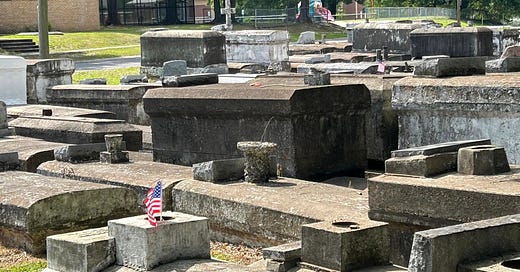Hidden in Plain Sight: The Tale of Baton Rouge's Benevolent Society Cemetery
Although it’s hard to ignore it once you see it, the Lutheran Cemetery located in the heart of Old South Baton Rouge was neglected for decades. Although historic, much of that history was lost or forgotten over time. Thankfully, there are people hard at work to not only maintain the grounds, but also unearth the history of those buried there.
On Monday, October 16, we took the short ride from the Electric Depot to the gates of the cemetery, which is located at 1735 Eddie Robinson Sr. Dr. There we were met by two people who have worked on both the historical and physical aspects of the cemetery’s preservation.
Meet the Guardians
At the entrance, we were greeted by Lillie Petit Gallagher. Her spark, energy, and vast knowledge immediately set the tone. She serves as our bridge to the past, unveiling the deep roots of this historic cemetery.
“One of our objectives is to educate people about the cemetery and about the history of the cemetery,” said Gallagher. “And Benjamin Franklin is a quote we use and motivates us - ‘a culture is known by the way they take care of their dead,’ and I think that can be said of this culture here.
“Unfortunately, people have died away,” she continued. “The cemetery hasn't been used in a long, long time for new burials. A lot of people don't know that their ancestors are buried here.”
Alongside her was Matt Thomas, the president of The University Lakes Improvement and Preservation Association. For seven years, this place has seen his dedication, ensuring that history isn't lost to time.
“We've been taking care of University Lake for 15 years,” he said. “And one of the guys on my board of directors told me about the cemetery seven years ago and asked if I would come see if I could help out.”
Thomas noted that the biggest challenge is when storms come through and knock down trees. The downed trees damage the crypts, and removal of the trees can also be expensive and difficult.
RELATED: Historic Baton Rouge cemetery needs help removing gravestones after May storm
“We have 10 crypts that need attention, that need to have the covers replaced,” he noted. “The covers run about 1,000 each. But we haven't been able to raise the funds to replace any of those.”
The Bee Tree
The entire property is lined with trees, but one in particular is infamously known as “the bee tree.”
“When you came through the center and you made the right turn, there was a tree that was full of bees,” Thomas recalled. “We finally got a volunteer beekeeper and her husband and we got a tree service to take down the tree and vacuum out the bees in the process.
“We had the news media here and everything,” he said. “It took about 6 hours, but we recovered almost all the bees.”
RELATED: Watch volunteers remove tree, and its bees, that threatened historic Baton Rouge cemetery
The tree service that volunteered the labor was Bayou Tree Service.
When Did The Cemetery Begin
Pause for a moment and travel back to the 1780s. Imagine a time when Benevolent Societies became the unsung heroes for both free and enslaved Africans, their lineage tracing back to West Africa. They served as a cushion against life's unpredictabilities, be it illness or ensuring dignified burials.
“There’s an article in the newspaper that indicated that $11,000 had been distributed by the Benevolent Society since 1858,” Gallagher noted. “So we know there was a Lutheran Benevolent Society in Baton Rouge in this area in 1958. It was organized and recorded with the Secretary of State in 1870.”
A fascinating detail: despite the name, the society wasn't strictly Lutheran. Martin Luther was revered, but the society chose its path.
“A local Lutheran Church saw something on television, and they assumed the cemetery was their responsibility. Ever since they have been volunteering with us for cleanups.”
RELATED: Volunteers continue efforts to clean, preserve Lutheran Cemetery
The Unanswered Questions
The land has been traced back to William Garig. Interestingly enough, he was a character of note in our Highland Road Cemetery tour. However, the Highland road location was exclusive to white landowners in the area, where the Lutheran cemetery may have originally been a slave cemetery in its first iteration.
READ MORE: Rediscovering Highland Road Cemetery: Baton Rouge's oldest known burial ground
The oldest burial they’ve been able to uncover is that of Cross Green, a former slave who died in the 1920s. Sadly, they have not been able to locate his grave.
“The only thing we have is a newspaper that says where the funeral was and where he was buried,” Gallagher explained.
So many of the graves have been lost, and many more remain simply unknown due to a lack of recordkeeping throughout the years.
The Legacy Continues
The original Benevolent Society may have dimmed, but the cemetery still stands tall, a testament to resilience and community. Lillie and Matt are only two of the many volunteers who have helped to restore what’s been lost and protect what remains.
“Now we're working with LSU, the School of Architecture Preservation Organization [under the direction of Professor Paul Holmquist],” he said. “They're developing an identifying marker because nobody knows that this is the Lutheran Cemetery unless you live in the area or you have someone buried here.”
The next volunteer event is scheduled for Saturday, November 4. They will get started around 9 a.m. and continue until about noon. Gloves, water, tools and a work plan will be provided.
Additionally, I have volunteered to help create a website for the group so they can collect all of this rich data and information and preserve it for those who want to learn more, share their knowledge about the history, or make a donation to help make repairs when needed.






